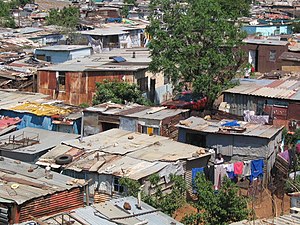Government-Housing Foundational
Reused from Wikipedia with Creative Commons License
'Housing, or more generally living spaces,[1] refers to the construction and assigned usage of houses or buildings collectively, for the purpose of sheltering people —the planning or provision delivered by an authority, with related meanings.[2] The social issue is of ensuring that members of society have a home in which to live, whether this is a house, or some other kind of dwelling, lodging, or shelter.[3] Many governments have one or more housing authorities, sometimes also called a housing ministry, or housing department.
Macroeconomy and housing
Previous research shows that housing price is affected by the macroeconomy. Financial crises, for example, usually reduce the price of housing.Template:Fact
Template:AnchorInformal housing

The term informal housing can include any form of shelter or settlement (or lack thereof) which is illegal, falls outside of government control or regulation, or is not afforded protection by the state.[4] As such, the informal housing industry is part of the informal sector.[5] To have informal housing status is to exist in ‘a state of deregulation, one where the ownership, use, and purpose of land cannot be fixed and mapped according to any prescribed set of regulations or the law.’[4] While there is no global unified law of property ownership[6] typically, the informal occupant or community will lack security of tenure and, with this, ready or reliable access to civic amenities (potable water, electricity and gas supply, sanitation and waste collection). Due to the informal nature of occupancy, the state will typically be unable to extract rent or land taxes.
The term informal housing is useful in capturing informal populations other than those living slum settlements or shanty towns, which are defined more narrowly by the UN Habitat as "contiguous settlement where the inhabitants are characterizes as having inadequate housing and basic services...often not recognised or addressed by the public authorities an integral or equal part of the city."[7]
Common categories or terms for informal housing include slums, slum settlements, shanty towns, squats, homelessness and pavement dwellers.
Informal housing in developing countries
Homelessness and insecurity of tenure are issues faced by populations around the world. However, there are particularly pernicious circumstances in developing countries that lead to a large proportion of the population resorting to informal housing. According to Saskia Sassen, in the race to become a ‘global city’ with the requisite state-of-the-art economic and regulatory platforms for handling the operations of international firms and markets,’ radical physical interventions in the fabric of the city are often called for, displacing ‘modest, low-profit firms and households’.[8]
If these households lack the economic resilience to repurchase in the same area or relocate to a place that offers similar economic opportunity, they are prime candidates for informal housing. For example, in Mumbai, India, this fast-paced economic growth, coupled with inadequate infrastructure, endemic corruption and the legacy of the restrictive tenancy laws[9] have left the city unable to house the estimated 54% who now live informally.[10]
Many cities in the developing world are experiencing a rapid increase in informal housing, driven by mass migration to cities in search of employment or fleeing from war or environmental disaster. According to Robert Neuwirth, there are over 1 billion (one in seven) squatters worldwide. If current trends continue, this will increase to 2 billion by 2030 (one in four), and 3 billion by 2050 (one in three).[11] Informal housing, and the often informal livelihoods that accompany them, are set to be defining features of the cities of the future.[12]
- ↑ Ranasinghe ,WC and Hemakumara, GPTS(2018), Spatial modelling of the householders' perception and assessment of the potentiality to improve the urban green coverage in residential areas: A case study from Issadeen Town Matara, Sri Lanka, Ruhuna Journal of Science,Vol 9(1); http://rjs.ruh.ac.lk/index.php/rjs/article/view/174
- ↑ Template:Cite OED
- ↑ Gwendolyn Wright, Building the Dream: A Social History of Housing in America (MIT press, 1983)
- ↑ 4.0 4.1 Template:Cite journal
- ↑ Template:Cite web
- ↑ Template:Cite book
- ↑ Template:Cite book
- ↑ Template:Cite book
- ↑ Template:Cite news
- ↑ Template:Cite book
- ↑ Template:Cite web
- ↑ Laquian, Aprodicio A. Basic housing: policies for urban sites, services, and shelter in developing countries (Ottawa: International Development Research Centre, 1983).
